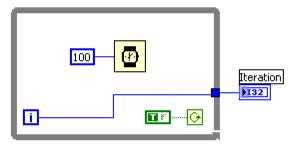ni clad practice test
Certified LabVIEW Associate Developerination
Question 1
How do you document a VI so that the description appears in the Show Context Help popup window?
- A. Use the VI Properties Documentation window
- B. Type in the Show Context Help window
- C. Create a free label on the front panel
- D. Edit the LabVIEW help files
Answer:
A
Question 2
Can a wire be used to pass data between loops that are intended to run in parallel?
- A. Yes
- B. No
Answer:
B
Question 3
Which of the following describes a Tab Control?
- A. A control that outputs ASCII values equal to the selected tab label
- B. A type of enumerated control
- C. A control that outputs a cluster of the controls / indicators on the tabs
- D. A controls that outputs the tab order of the controls on the front panel
Answer:
B
Question 4
What is an advantage of using a Strictly Typed VI ref num?
- A. The data types of the target VI are known at compile time
- B. The data types passed to the VI can change programmatically
- C. You can flatten the data to a string to improve code performance
- D. Causes dynamically loaded VIs to be loaded at the start of execution
Answer:
A
Question 5
A coercion dot indicates that:
- A. The data types are consistent
- B. A polymorphic operation will be performed on the data
- C. A data buffer is created to handle data conversion
- D. Data values are being coerced because they are out of range
Answer:
C
Question 6
Which of the following statements is true about the following block diagram?

- A. The loop will execute once and the iteration terminal, , will output a value of one
- B. The loop w ill execute once and the iteration terminal, , will output a value of zero
- C. The loop will execute infinitely and the program will have to be aborted
- D. The loop will not execute and the iteration terminal, , will return a null value
Answer:
C
Question 7
Which of the following can not be used to transfer data?
- A. Semaphores
- B. Queues
- C. Notifiers
- D. Local variables
Answer:
A
Question 8
Which of the following terminals controls how many times a For loop executes?
A.
B.
C.
D.
Answer:
D
Question 9
You have a control on the front panel of a VI and you need to modify one of its properties at run
time. Which of the following is the best approach you would take?
- A. Create an implicit property node and select the property to modify
- B. Create a control reference, pass the reference to a property node and select the property to modify
- C. Create a linked shared variable and select the property to modify the property
- D. Create a local variable and select the property to modify
Answer:
A
Question 10
Formula nodes accept which of the following operations?
- A. Basic programming language instructions Input and Print
- B. Embedding of SubVIs within the Formula Node
- C. Pre and post increment (++) and decrement (--) as in the C language
- D. The use of nested Formula Node structures
Answer:
C
Question 11
Which of the following is the best method to update an indicator on the front panel?
- A. Use a Value property node
- B. Wire directly to the indicator terminal
- C. Use a local variable
- D. Use a functional global variable
Answer:
B
Question 12
Which of the following functions assembles Cluster elements by their owned labels?
- A. Unbundle by Name
- B. Unbundle
- C. Bundle by Name
- D. Bundle
Answer:
C
Question 13
What is the output of the Build Array function in the following block diagram when Concatenate
Inputs is selected?
- A. 1-D Array of {1, -4, 3, 7, -2, 6}
- B. b.1-D Array of {1, 7, -4, -2, 3, 6}
- C. c.2-D Array of {{1, -4, 3, 0}, {7, -2, 6}}
- D. d.2-D Array of {{1, -4, 3}, {7, -2, 6}}
Answer:
A
Question 14
What is the output of the Initialize Array function after the following code has executed?
- A. a.1-D Array of {3, 3, 3, 3}
- B. b.1-D Array of {4, 4, 4}
- C. c.1-D Array of {3, 4}
- D. d.1-D Array of {4, 3}
Answer:
A
Question 15
What is one disadvantage of using the State Machine VI architecture?
- A. A State Machine can only traverse states in order
- B. If two state changes occur at the same time, only the first state change will be handled and the second will be lost
- C. The diagram becomes significantly larger when changing from a general architecture to a State Machine
- D. State Machines cannot acquire data or use DAQ functions
Answer:
B